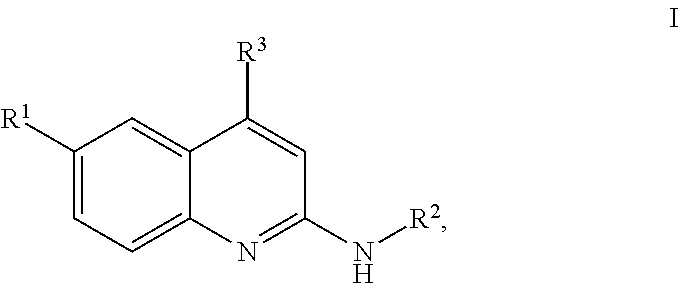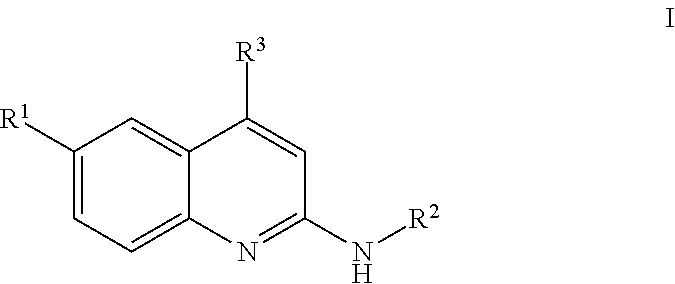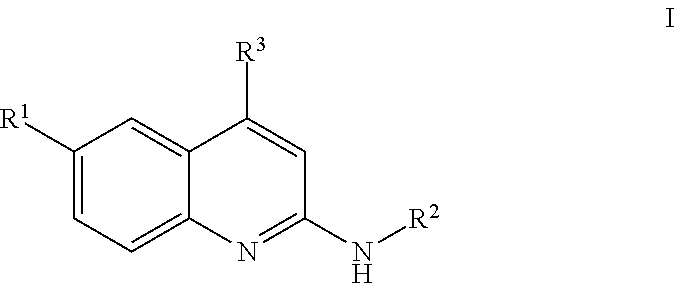Quinolines
a technology of quinolines and quinolines, which is applied in the field of quinolines, can solve the problems of limited pharmacological characterisation of the 5-htsub>5a /sub>receptor and lack of behavioural data, and achieve the effect of good affinity to the 5-ht5a receptor
- Summary
- Abstract
- Description
- Claims
- Application Information
AI Technical Summary
Benefits of technology
Problems solved by technology
Method used
Image
Examples
example 1
N2-(2-Phenoxy-ethyl)-N6-pyridin-3-ylmethyl-quinoline-2,6-diamine
Step A
[0311]2,6-Dichloroquinoline (1.0 g, 5.1 mmol) and 2-phenoxyethylamine (1.5 g, 11 mmol) were microwaved at 120° C. for 1 h. The reaction mixture was purified by flash chromatography on silica gel (cyclohexane / ethyl acetate 100:0->70:30 gradient). (6-Chloro-quinolin-2-yl)-(2-phenoxy-ethyl)-amine was obtained as a light yellow solid (1.1 g, 73%), MS: m / e=299.3 (M+H+).
Step B
[0312](6-Chloro-quinolin-2-yl)-(2-phenoxy-ethyl)-amine (150 mg, 0.503 mmol) was dissolved in 2 mL dioxane. Argon was bubbled through the solution for 2 minutes to remove oxygen. 3-Picolylamine (165 mg, 1.53 mmol), sodium tert.-butylate (119 mg, 1.24 mmol) and 1,1′-2-(dimethylamino)ferrocen-1-yl-palladium(II) chloride dinorbornylphosphine (16 mg, 0.03 mmol) were added. The reaction mixture was stirred in a sealed tube at 115° C. for 16 h. The solvent was evaporated and the residue purified by flash chromatography on silica gel (dichloromethane / metha...
example 2
(2-Methoxy-benzyl)-[6-((E)-2-pyridin-4-yl-vinyl)-quinolin-2-yl]-amine
Step A
[0313]6-Bromo-2 chloroquinoline (727 mg, 3.0 mmol) and 2-methoxybenzylamine (823 mg, 6.0 mmol were stirred in a sealed tube at 120° C. for 16 h. The reaction mixture was purified by flash chromatography on silica gel (cyclohexane / ethyl acetate 100:0->70:30 gradient). (6-Bromo-quinolin-2-yl)-(2-methoxy-benzyl)-amine was obtained as a light yellow solid (868 mg, 84%), MS: m / e=343.1 (M+H+).
Step B
[0314](6-Bromo-quinolin-2-yl)-(2-methoxy-benzyl)-amine (200 mg, 0.583 mmol) was dissolved in 2 mL dimethylformamide. 4-Vinylpyridine (80 mg, 0.762 mmol), triethylamine (77 mg, 0.760 mmol), tri-o-tolylphosphin (7 mg, 0.023 mmol) and palladium(II)acetate (3 mg, 0.013 mmol) were added. The reaction mixture was stirred in a sealed tube at 100° C. for 16 h. The reaction mixture was poured into 30 mL water and extracted three times with ethyl acetate (30 mL each). The combined organic extracts were dried with sodium sulfate, f...
example 3
(2-Methoxy-benzyl)-[6-(2-pyridin-4-yl-ethyl)-quinolin-2-yl]-amine
[0315](2-Methoxy-benzyl)-[6-((E)-2-pyridin-4-yl-vinyl)-quinolin-2-yl]-amine (example 2, 51 mg, 0.139 mmol) was dissolved in 20 mL ethanol. Palladium on charcoal (10%, 15 mg, 0.014 mmol) was added and the reaction mixture war hydrogenated with a hydrogen balloon overnight. The palladium was filtered off and the solvent was evaporated. The title compound was obtained as a yellow oil (40 mg, 78%), MS: m / e=370.1 (M+H+).
PUM
| Property | Measurement | Unit |
|---|---|---|
| pH | aaaaa | aaaaa |
| volume | aaaaa | aaaaa |
| temperature | aaaaa | aaaaa |
Abstract
Description
Claims
Application Information
 Login to View More
Login to View More - R&D
- Intellectual Property
- Life Sciences
- Materials
- Tech Scout
- Unparalleled Data Quality
- Higher Quality Content
- 60% Fewer Hallucinations
Browse by: Latest US Patents, China's latest patents, Technical Efficacy Thesaurus, Application Domain, Technology Topic, Popular Technical Reports.
© 2025 PatSnap. All rights reserved.Legal|Privacy policy|Modern Slavery Act Transparency Statement|Sitemap|About US| Contact US: help@patsnap.com



